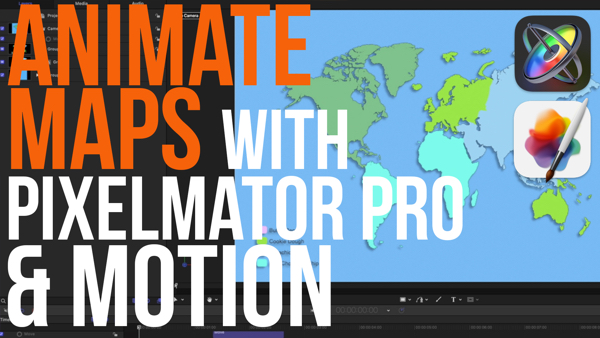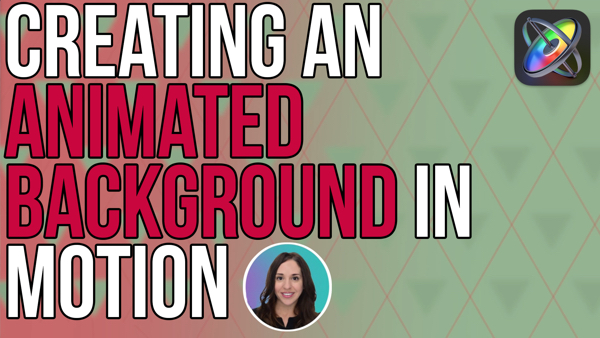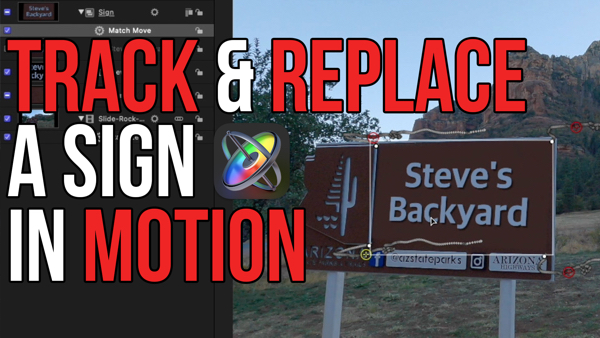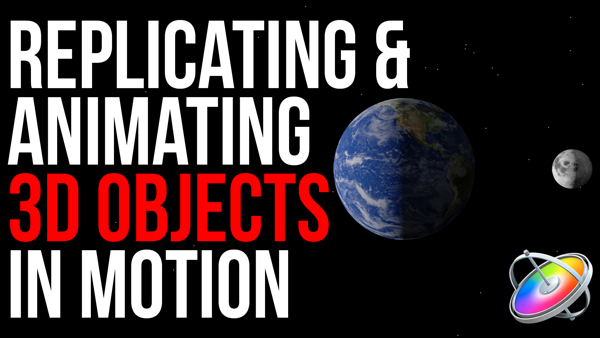Creating a Heart Beat Effect in Motion 5
In episode 23 of Motion Magic, Mark shows you how to create an animated heart beat with a paint stroke and an animated gradient.
In this episode, I’ll show you how to create this animated heartbeat effect.
I’m Mark Spencer from RippleTraining.com. Welcome to Motion Magic where you’ll learn visual effects and motion graphics in under 5 minutes.
Here we are in Motion. I’ve used Motion’s Grid generator and
the Vignette filter to create a background, and I’ve used the Bezier tool to draw a heartbeat pattern. If I select it, we can see in the Shape Inspector, in the Style pane, that I’ve disabled the Fill, and in the Outline section, I’ve set the Brush Type to Airbrush for a softer edge.
To animate this pattern, I’m going to select the Animation group, then select the Rectangle tool, and draw a rectangle that covers the pattern.
I’ll press Escape, and in the Shape Inspector’s Style pane, I’ll set the Fill Mode to Gradient. Then I’ll right click in the Canvas, select Edit Gradient, and create a horizontal gradient with a single bluish-green color. I’ll Option-drag out a second opacity tag, and set it to black so that the rectangle starts at the right at full opacity and fades out to the left.
Next I’ll press Shift-S for the selection tool, select the group containing the rectangle, drag the rectangle off-screen left, turn on recording, move forward 3 seconds, and drag it off screen right, and turn off recording. From the Window menu, I’ll select the Keyframe editor, change the keyframe interpolation for X to linear, and change after last keyframe to repeat. The rectangle now passes repeatedly over the heartbeat pattern.
I’ll select the rectangle, then from the Object menu, I’ll choose Add Image Mask, and in the Heads Up Display, set the Source Channel to Luminance. Then I’ll drag the heartbeat pattern into the well. The pattern now animates onto the screen fading off with a long tail.
To make a bright dot at the head of the animating heartbeat, I’ll select the same group, then use the Line tool with the Shift key held down to create a vertical line.
I’ll press Shift-S, then in the Inspector, I’ll set it to Airbrush and adjust its Width and Color.
Because I animated the group it’s contained in, it’s already animated, so I can move the playhead forward in order to place it at the head of the pattern.
I want to mask this line with a thicker heartbeat pattern, so I’ll select the current one and press Command-D to duplicate it and name it Head. Before changing it, I’ll select the Line, press Shift-Command-M to add an Image Mask, drag the Head layer to the well, and set the Source Channel to Luminance.
Now I can select the Head shape, and in the Inspector, adjust the width to create a large head to the pattern.
Click the Subscribe button below. If you have an idea, comment or suggestion, leave those below as well. Go to RippleTrainging.com for fast professional training on Final Cut Pro, Motion and DaVinci Resolve from industry professionals.
I’m Mark Spencer from RippleTraining.com. Welcome to Motion Magic where you’ll learn visual effects and motion graphics in under 5 minutes.
Here we are in Motion. I’ve used Motion’s Grid generator and
the Vignette filter to create a background, and I’ve used the Bezier tool to draw a heartbeat pattern. If I select it, we can see in the Shape Inspector, in the Style pane, that I’ve disabled the Fill, and in the Outline section, I’ve set the Brush Type to Airbrush for a softer edge.
To animate this pattern, I’m going to select the Animation group, then select the Rectangle tool, and draw a rectangle that covers the pattern.
I’ll press Escape, and in the Shape Inspector’s Style pane, I’ll set the Fill Mode to Gradient. Then I’ll right click in the Canvas, select Edit Gradient, and create a horizontal gradient with a single bluish-green color. I’ll Option-drag out a second opacity tag, and set it to black so that the rectangle starts at the right at full opacity and fades out to the left.
Next I’ll press Shift-S for the selection tool, select the group containing the rectangle, drag the rectangle off-screen left, turn on recording, move forward 3 seconds, and drag it off screen right, and turn off recording. From the Window menu, I’ll select the Keyframe editor, change the keyframe interpolation for X to linear, and change after last keyframe to repeat. The rectangle now passes repeatedly over the heartbeat pattern.
I’ll select the rectangle, then from the Object menu, I’ll choose Add Image Mask, and in the Heads Up Display, set the Source Channel to Luminance. Then I’ll drag the heartbeat pattern into the well. The pattern now animates onto the screen fading off with a long tail.
To make a bright dot at the head of the animating heartbeat, I’ll select the same group, then use the Line tool with the Shift key held down to create a vertical line.
I’ll press Shift-S, then in the Inspector, I’ll set it to Airbrush and adjust its Width and Color.
Because I animated the group it’s contained in, it’s already animated, so I can move the playhead forward in order to place it at the head of the pattern.
I want to mask this line with a thicker heartbeat pattern, so I’ll select the current one and press Command-D to duplicate it and name it Head. Before changing it, I’ll select the Line, press Shift-Command-M to add an Image Mask, drag the Head layer to the well, and set the Source Channel to Luminance.
Now I can select the Head shape, and in the Inspector, adjust the width to create a large head to the pattern.
Click the Subscribe button below. If you have an idea, comment or suggestion, leave those below as well. Go to RippleTrainging.com for fast professional training on Final Cut Pro, Motion and DaVinci Resolve from industry professionals.




